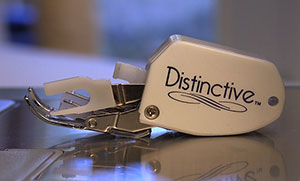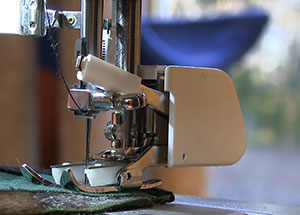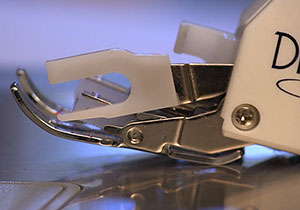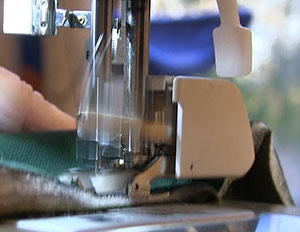 Home - How-To's - Reviews - Links - Contact - About Us
Home - How-To's - Reviews - Links - Contact - About UsOur other sites: FlyingRC.net - NewWoodworker.com - NewMetalworker.com
 Home - How-To's - Reviews - Links - Contact - About Us
Home - How-To's - Reviews - Links - Contact - About Us
Text, photos and video by Tom Hintz
Posted – 1-9-2018

While expanding my sewing endeavors to better support my FlyingRC.net site I had no idea that a core project would present a frustrating mystery that threatened to compromise the quality of my work. Whenever I sewed the three-layer fabric sandwich I had designed for my FlyingRC.net Protector Sets, the top layer seemed to stretch while the lower two layers did not. The outer canvas layer would begin to bulge up as the stitching approached the next of the pins securing the perimeter of the sandwich layers to one another. The longer the line of stitches, the more pronounced the “bulge” became. It was, to say the least, frustrating and frequently led to my cats vacating the area when bad and/or louder-than-normal language filled the air.
From the first time this bulge arose (so to speak) I somehow convinced myself that the canvas top layer was stretching. I’m not sure how I got myself to accept that canvas was stretching more than batting and flannel below it but that is exactly what I did. Now that I know how this problem occurred I am even less proud of my obviously minimal understanding of the physics of friction. (I think that is what I didn’t understand anyway) However, me whiffing on anything relating to physics should surprise no one.
Sewing machines are relatively simple devices in this world of CNC (computer numerically controlled) machining centers, and I assume lack the ability to plot against me. I am a man, so it is only natural for me to dominate machines regardless of whether I know how to operate them correctly or not. However, in this instance I would discover that I was wrong, and the sewing machine was not. I simply did not understand the dynamics of sewing multiple layers of fabric.

While researching the next sewing machine for Review on yesmensew.com, I noticed an included accessory called the “Walking Foot”. At first, it attracted my attention simply because it had a decidedly mechanical look to it which automatically perks up my man genes. Then, in the description I noticed that it was designed to equalize the feeding of multiple layers of fabric. Adding frustration to this was that my Singer 7640 Confidence™ came with a Walking Foot that was now in one of my sewing “organizers” which in my shop loosely translates to some degree of “lost”. I did find it though.
The Walking Foot “walks” because it has a set of feed dogs (teeth) that move the top layer of fabric just like the ones in the bed of the machine move the bottom layer of fabric. Moving the top and bottom layers at the same rate “encourages” the middle layer to come along for the ride. I suspect that if there are 4 or 5 layers, the middle ones will also come along with the outer layers.
When installed correctly, the up and down motion of the needle drives the Walking Foot lever that operates its feed dogs and times them to the ones in the sewing machine. For some reason Singer decided to simply lay the operating arm on top of the needle bolt and let a small spring (and presumably gravity) bring that lever back down as the needle went down. This concept never made much sense to me considering the speed at which the needle can go up and down in even a cheap sewing machine.
The “un-captured” operating arm on the Singer Walking Foot provided an explanation for its inconsistent performance. As I was sewing I could occasionally hear the sound made by the Singer Walking Foot grow quieter. At the same time, the beginnings of a bulge appeared in the top layer of fabric. I later noticed in these “quiet times” the actuating lever on the Singer Walking Foot was either sticking in the up position or bouncing as the needle bolt slapped it on the upstroke. When the sound returned to the normal “clickety” the Singer Walking Foot actuating arm was either on the needle bolt or very close to it and would stop increasing the size of the bulge. Sometimes my grasp of the obvious is astounding. I knew that eliminating the bounce in the actuating arm would go a long way to eliminating the bulge syndrome. By the way, I suspect there are walking feet out there from other manufacturers that suffer the same issue, so we can’t blame this whole issue on Singer.

A quick search for a better Walking Foot led me to the Distinctive Even-Feed Walking Foot. The first feature that caught my attention was the operating arm that terminates in a fork shaped end that captures the needle bolt. That one feature was enough for me to hit the “buy” button and get one on its way to me. Aside from that operating arm fork the Distinctive Even-Feed Walking Foot looks very much like other Walking Feet.
The Distinctive Even-Feed Walking Foot mounted to my presser foot leg without modification to anything. The fork-shaped end of the operating arm fit over the needle clamp bolt with very little excess clearance. Overall the Distinctive Even-Feed Walking Foot appears to be a little better made than the other Walking Foot I had been trying.
I tried using the Distinctive Even-Feed Walking Foot to sew the same three-layer sandwich, canvas, batting and flannel, that had been giving me fits. With the regular pressure foot installed I made a pass down the fabric sandwich, layers pinned as I had been doing when the “stretching” issue occurred. The bulge appeared just as it always did. Before installing the Distinctive Even-Feed Walking Foot I cut that row of stitches from the fabric sandwich and re pinned the edges of the fabric together to be sure the conditions were consistent. The length of the line of stitches also remained identical.
After installing the Distinctive Even-Feed Walking Foot following the “instructions” (more on those below) I made several passes down the same fabric sandwich that bulged every time with the Singer Walking Foot. With the Distinctive Even-Feed Walking Foot the difference was remarkable, and bulge-free. I made other “confirmation” (convincing myself) passes down that same fabric sandwich, cutting away the previous rows of stitches before each pass. Each time the Distinctive Even-Feed Walking Foot produced zero bulging. I had discovered the problem and once again it was largely me.

One line on the front of that packaging card did concern me a little. It says, “Bonus! Includes Complete Instructions”. I have seen this kind of instruction-based baloney from other manufacturers. Very often those so-called instructions aren’t instructive but do provide test materials for those wishing to practice code-breaking. The Distinctive Even-Feed Walking Foot is a good product with a dumb bit of marketing on the packaging. Not so incidentally, the “Complete Instructions” pretty much suck like too many instructions these days.
It is important to note that both Singer sewing machines I had in the shop had come with the Singer Walking Foot. The solution for the problem I was causing was literally right there, packed with both sewing machines I had Reviewed. I would find these versions of the Walking Foot to be inferior to the Distinctive Even-Feed Walking Foot but they did point to the solution to my “bulge” issue. I’d like to think that I had a legitimate reason for overlooking the Walking Foot as such an obvious cure, but the reality is I simply whiffed it. Right now, the manufacturers are screaming at their computer screens, “read the ^%$^&* instructions!”. Of course, they are spot on correct.
The Distinctive Even-Feed Walking Foot shown in this story sells for around $29.99 (12-29-2017) while the Singer version sells for around $20 (12-31-2017). I am not rich, nor do I make believe that I have a big sewing-related budget. That said, the Distinctive Even-Feed Walking Foot is worth every penny to me in terms of frustration relieved and fabric/shop time saved that had been expended on trying to fix or re making fabric panels ruined by the differing feed rates induced by the lesser Walking Foot versions.
After testing and using the Distinctive Even-Feed Walking Foot in my shop it is on my “right tool for the job” list. If you are sewing stacked fabrics and it is not going well, consider the Distinctive Even-Feed Walking Foot. It has had a tremendous positive affect on my psyche, my cats level of “bad word-induced skittishness” and my sewing-related productivity.
See our video on this product - Click Here
Have a comment on this Review? - Email Me!
All yesmensew.com written, photographic and drawn materials are property of and copyright by Tom Hintz and NewWoodworker.com LLC 2013-2019. Materials cannot be used in any way without the prior written permission of the owner.